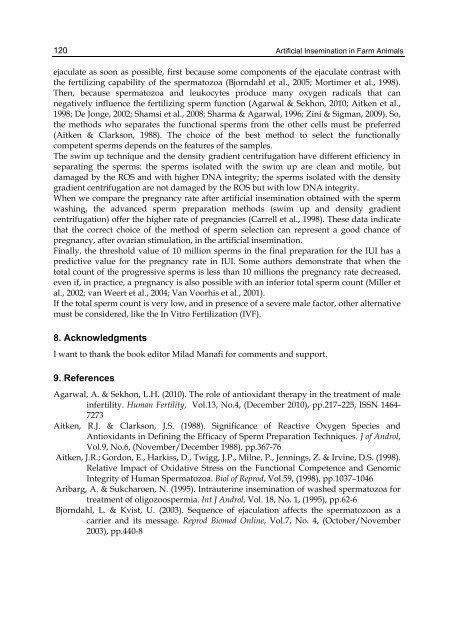ARTIFICIAL INSEMINATION IN FARM ANIMALS - Phenix-Vet
ARTIFICIAL INSEMINATION IN FARM ANIMALS - Phenix-Vet
ARTIFICIAL INSEMINATION IN FARM ANIMALS - Phenix-Vet
You also want an ePaper? Increase the reach of your titles
YUMPU automatically turns print PDFs into web optimized ePapers that Google loves.
120Artificial Insemination in Farm Animalsejaculate as soon as possible, first because some components of the ejaculate contrast withthe fertilizing capability of the spermatozoa (Bjorndahl et al., 2005; Mortimer et al., 1998).Then, because spermatozoa and leukocytes produce many oxygen radicals that cannegatively influence the fertilizing sperm function (Agarwal & Sekhon, 2010; Aitken et al.,1998; De Jonge, 2002; Shamsi et al., 2008; Sharma & Agarwal, 1996; Zini & Sigman, 2009). So,the methods who separates the functional sperms from the other cells must be preferred(Aitken & Clarkson, 1988). The choice of the best method to select the functionallycompetent sperms depends on the features of the samples.The swim up technique and the density gradient centrifugation have different efficiency inseparating the sperms: the sperms isolated with the swim up are clean and motile, butdamaged by the ROS and with higher DNA integrity; the sperms isolated with the densitygradient centrifugation are not damaged by the ROS but with low DNA integrity.When we compare the pregnancy rate after artificial insemination obtained with the spermwashing, the advanced sperm preparation methods (swim up and density gradientcentrifugation) offer the higher rate of pregnancies (Carrell et al., 1998). These data indicatethat the correct choice of the method of sperm selection can represent a good chance ofpregnancy, after ovarian stimulation, in the artificial insemination.Finally, the threshold value of 10 million sperms in the final preparation for the IUI has apredictive value for the pregnancy rate in IUI. Some authors demonstrate that when thetotal count of the progressive sperms is less than 10 millions the pregnancy rate decreased,even if, in practice, a pregnancy is also possible with an inferior total sperm count (Miller etal., 2002; van Weert et al., 2004; Van Voorhis et al., 2001).If the total sperm count is very low, and in presence of a severe male factor, other alternativemust be considered, like the In Vitro Fertilization (IVF).8. AcknowledgmentsI want to thank the book editor Milad Manafi for comments and support.9. ReferencesAgarwal, A. & Sekhon, L.H. (2010). The role of antioxidant therapy in the treatment of maleinfertility. Human Fertility, Vol.13, No.4, (December 2010), pp.217–225, ISSN 1464-7273Aitken, R.J. & Clarkson, J.S. (1988). Significance of Reactive Oxygen Species andAntioxidants in Defining the Efficacy of Sperm Preparation Techniques. J of Androl,Vol.9, No.6, (November/December 1988), pp.367-76Aitken, J.R.; Gordon, E., Harkiss, D., Twigg, J.P., Milne, P., Jennings, Z. & Irvine, D.S. (1998).Relative Impact of Oxidative Stress on the Functional Competence and GenomicIntegrity of Human Spermatozoa. Biol of Reprod, Vol.59, (1998), pp.1037–1046Aribarg, A. & Sukcharoen, N. (1995). Intrauterine insemination of washed spermatozoa fortreatment of oligozoospermia. Int J Androl, Vol. 18, No. 1, (1995), pp.62-6Bjorndahl, L. & Kvist, U. (2003). Sequence of ejaculation affects the spermatozoon as acarrier and its message. Reprod Biomed Online, Vol.7, No. 4, (October/November2003), pp.440-8










